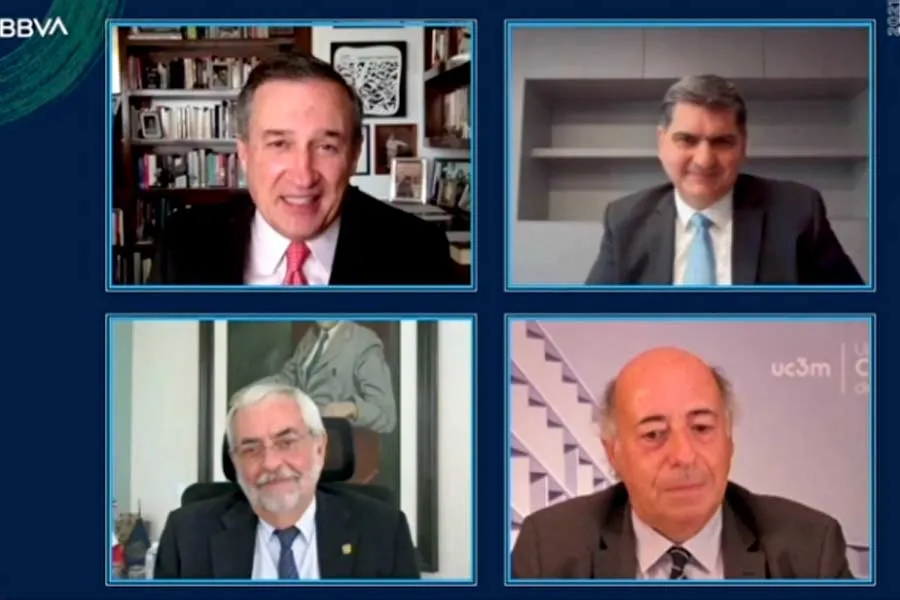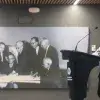How has the context of the pandemic prompted universities to take action for the future? What changes have been executed to continue preparing young people in an evolving world?
Rector and Executive President of Tec de Monterrey David Garza discussed the above with Enrique Graue, Rector of the National Autonomous University of Mexico (UNAM), and Juan Romo Rector of Charles III University of Madrid, Spain.
The university leaders met during the virtual panel “Universities contributing to economic reactivation,” moderated by journalist Leonardo Kourchenko, at the Mexico-Spain Dialogs event organized by the BBVA Foundation.
“The response of educational institutions (to the pandemic) was unprecedented. What’s interesting is how we continue because we’ve learned so many aspects that can be kept and others that must be rethought and reinstated as part of a new approach,” said Garza.

The pandemic: triggering progress
Despite challenges to the three universities, such as migrating to a 100% digital environment to guarantee academic continuity, technological gaps, and the adaptation of teachers and students, the rectors agree that there was progress in several aspects.
Garza said that during the pandemic, his institution focused on discovering new opportunities, both in teaching and operational aspects.
“We realized that we can offer international opportunities to many more students and attract the talent of teachers from different parts of the world who are just a click away from interacting with our community,” said the rector of the Tec.
“There’s also the idea of remote and virtual laboratories. While it’s true that some laboratory activities have to be carried out physically, there are others in which students can even manipulate instruments remotely,” he added.
During the return to a new normal, universities are taking advantage of the benefits offered by technology to provide different learning experiences that can be added to face-to-face ones.
“We’ve learned that young people can study many things at home, without affecting their learning, and are very open to the flexibility that a synchronous or asynchronous hybrid system offers,” said the rector of UNAM.
“We can offer international opportunities to many more students and attract the talent of teachers from different parts of the world who are just a click away.” - David Garza
A boost to ongoing initiatives
Rector of Charles III University of Madrid Juan Romo said that higher education institutions have accelerated initiatives that had already begun prior to the pandemic, taking advantage of what they’ve learned during the COVID period.
“The pandemic has expedited these transformations that were already underway. For example, we’ve teamed up with four universities to share degree courses. Students can take one course in Madrid and another in Barcelona, or in another European country,” said Romo.
The rector of the Tec added that the disruption caused by the pandemic boosted learning and skills development approaches that were already in place, such as Industry 4.0 and adaptability and resilience skills.
“One element that the pandemic also accelerated was the issue of student wellbeing. It’s going to become more important for young people to learn how to manage their own wellbeing.
“There are skills we have to develop in students regarding issues such as interpersonal skills, leadership, and adapting to change. They’re very difficult to design and evaluate, but this is something we need to focus on,” said Garza.

Social experience: one aspect to be addressed
Rector of UNAM Enrique Graue said that although no damage has been perceived in the young people’s learning, there are elements that must be addressed, such as their social experience.
“We’re aware that a university’s social experience, talking with students, being in the corridors with professors, is a part of the university that we can’t lose. We have to gradually reach an intermediate point,” said Graue.
“Students will want to return to campus, to talk and debate, but that doesn’t mean they can’t study many disciplines remotely,” Kourchenko said.
The rector of the Tec shared the concept that universities should move towards multi-diversity.
“This new concept opened up by the pandemic includes several ‘multis.’ One is multi-modal, face-to-face education will continue to exist, but online or hybrid forms are being added; multidisciplinary, meaning there will be more interaction between different disciplines.
“Also, multi-experiential, you actually learn at university, but you do it in other contexts, creating challenges; multinational, with the concept of a university in which the student can study at several partner universities,” Garza explained.
In addition to this, the president of the Tec said that there’s also the concept of multistage, in which students can return to university to participate in various activities even after graduation.
“There are skills we have to develop in students regarding issues such as interpersonal skills, leadership, and adapting to change.” - David Garza
Universities of the future
Romo points out that he sees universities going deeper into interdisciplinary aspects, internationalization, and innovation.
“All this technology helps us to be international and participate in university networks, as well as being innovative and addressing complex problems in an interdisciplinary way,” said the rector of Charles III University.
For his part, the rector of UNAM sees universities whose students take more advantage of a hybrid environment, as well as learning through continuing education programs.
“Today, in Mexico, only 40% of young people of higher education age can do so because of our capacity; so, here we have a world of possibilities to provide more and better education; there’s going to be great deal of student mobility,” said Graue.
Garza explained that the Tec’s Vision for 2030 focuses on the flourishing of humanity in an increasingly automated world with greater use of advanced technology and artificial intelligence.
“We’re promoting the three ‘i’s’: investigation, internationalization, and innovation. We’ll be reaching more audiences, mainly in lifelong learning and micro-credentials; we’re going to be seeing an evolution in the role of teachers and different pedagogical models,” Garza concluded.
YOU SHOULD ALSO READ:





